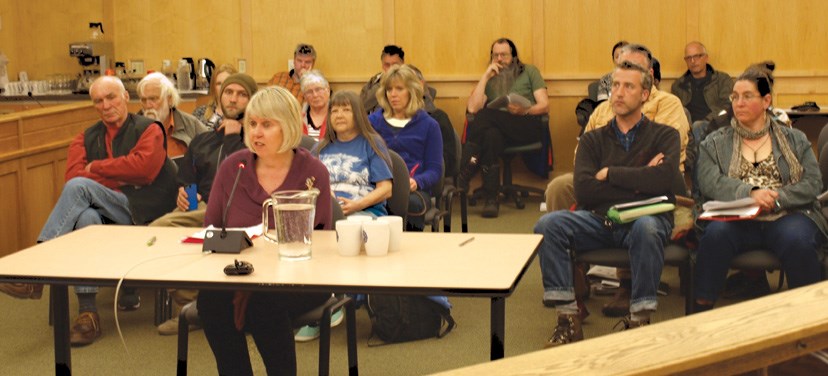Setbacks were one of the biggest issues raised by the 50 or so people who came out to an April 12 public hearing on the Sunshine Coast Regional District’s (SCRD) proposed AG zones.
If adopted, the AG zones will replace the current RU3 (Rural Use) zones. The SCRD said the goal is to “broaden agricultural and farm opportunities” and to bring zoning for land that falls within the Agricultural Land Reserve (ALR) in line with various provincial regulations.
But several people at the hearing said having setbacks of up to 30 metres from property lines for some activities, like slaughtering and processing meat, could actually make it harder for people to use their land for farming.
Mary Degan of Elphinstone was one of them. “What I see here is a huge amount of limitation,” she said. “The purpose of ALR is to be farmed and I think for me, the challenge I see is the limits we’re placing on land and these huge setbacks are going to mean people aren’t going to be able to produce their own food in the same way.”
One person even put forward the notion that the setbacks could open the door for some property owners to apply to be removed from the Agricultural Land Reserve by claiming the property can’t be farmed.
Others told the hearing, however, that large setbacks should be maintained for things like buildings used to store chemicals.
At one point, hearing chair Ian Winn, director for West Howe Sound, took the unusual step of asking for a show of hands from people who agreed setbacks are a problem – almost everyone raised their arms.
There were also concerns that rules for secondary dwellings would be too restrictive, and worries that it would be unfair to allow operations like breweries and wineries to serve food and beverages while prohibiting food-only producers from doing something similar.
Vancouver city councillor, and part-time Sunshine Coast resident, Adriane Carr spoke on the home building rules. Carr and her family own two properties in West Howe Sound that have RU3 zoning. Carr said her son and daughter and their partners are hoping to live there and establish farms in the future, but some of the rules around auxiliary dwellings would make it impractical to have an extended family live on, and work, the land.
Carr cited the example of allowing only a 55-square-metre (590-sq.-ft.) unit above a single-storey farm use building.
“Fifty-five square metres, 590 square feet, is really too small to think about having more than one bedroom,” she said. “It’s inconsistent with the ability to have and to raise one or more children … We are appealing to you to increase the size from 55 square metres to enable a truly family-oriented dwelling to be built on the second floor of an auxiliary building.”
SCRD senior planner David Rafael read out sections from written submissions, including one from a Sechelt resident that outlined the issue around the “food and beverage service lounges.” The submission pointed out that it doesn’t make sense for an apple grower not to be allowed to sell visitors to the farm a slice of pie and a coffee, but suddenly allow it if the farmer starts making cider with their apples. It said without changes to that part of the bylaw, the SCRD would be “promoting alcohol tourism, not agri-tourism.”
SCRD staff also noted that many of the proposed regulations on setbacks and auxiliary dwellings are based on Ministry of Agriculture recommendations, which were drafted with large-scale farming in mind.
The AG zone bylaw is expected to come back to the SCRD board for further consideration next month.



